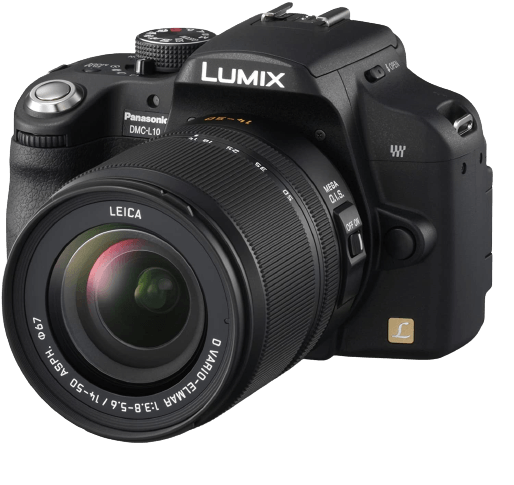Panasonic Lumix DMC-L10 Specs and Scores

The Panasonic Lumix DMC-L10 receives a score of 34/100, which reflects its general specifications. Announced on August 30, 2007, and released the same year, this DSLR camera has a launch price of $964. The camera measures 135 x 96 x 78mm and weighs 556g or 1.23lbs.
Considering its specifications, the Lumix DMC-L10 has become less competitive in today’s market. Its size, weight, and features may not be as appealing to modern consumers who seek more advanced options in DSLR cameras.
Panasonic Lumix DMC-L10 Overview and Optics
The Panasonic Lumix DMC-L10’s optics score is 37/100. This camera features a 10.1-megapixel resolution, a shooting speed of 3 frames per second, and a Live MOS sensor powered by the Venus Engine HD III processor. With a DXOMARK score of 55, the sensor is not highly competitive in today’s market.
The camera uses a Micro Four Thirds sensor and a Micro 4/3 lens mount, which provide decent performance in a compact form factor. However, it lacks image stabilization, which may affect image quality in certain shooting situations. The aspect ratio of the Lumix DMC-L10 is 4:3, which is standard for most digital cameras.
Considering the specifications, the Panasonic Lumix DMC-L10’s optics are not outstanding when compared to current market offerings. The camera’s performance may not meet the expectations of users seeking advanced optics and image quality.
Panasonic Lumix DMC-L10 Video Performance
Despite most cameras having video capabilities, the Panasonic Lumix DMC-L10 lacks this feature. This camera focuses solely on photography without offering video functionality.
Panasonic Lumix DMC-L10 Features and Benefits
The Panasonic Lumix DMC-L10 obtains a feature score of 28 out of 100. This score reflects the camera’s specifications and how they measure up in today’s market. The Lumix DMC-L10 is equipped with a 2.5-inch screen with a resolution of 207,000 dots. Although lacking a touchscreen, it does have a flip screen, offering flexibility in capturing images from various angles.
Unfortunately, the camera does not possess GPS capabilities, which limits its usefulness for location-based photography. However, it does include WIFI, enabling easy transfer of photos to other devices. The absence of Bluetooth connectivity is another drawback of this camera.
Taking these specifications into account, the Panasonic Lumix DMC-L10 has a mix of useful and outdated features. While the flip screen and WIFI capabilities are beneficial, the lack of GPS, Bluetooth, and a touchscreen may deter potential buyers in search of a more advanced camera.
Panasonic Lumix DMC-L10 Storage and Battery
The storage and battery of the Panasonic Lumix DMC-L10 receive a score of 27/100. The camera has one memory card slot, which accepts SD, SDHC, and MMC cards. In today’s market, this limited compatibility falls short, as many cameras now offer multiple card slots and support for a wider range of memory cards.
Regarding battery life, the DMC-L10 offers 450 shots per charge with its DMW-BLB13 battery. This battery life is considered average compared to current models, and the lack of USB charging is a drawback. Modern cameras often provide USB charging options for added convenience.
In the context of storage and battery performance, the Panasonic Lumix DMC-L10 does not excel in today’s market. With limited memory card compatibility and average battery life, it falls behind more advanced models.
